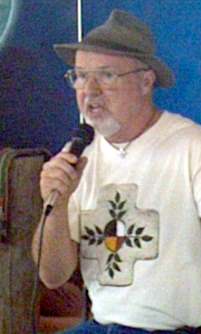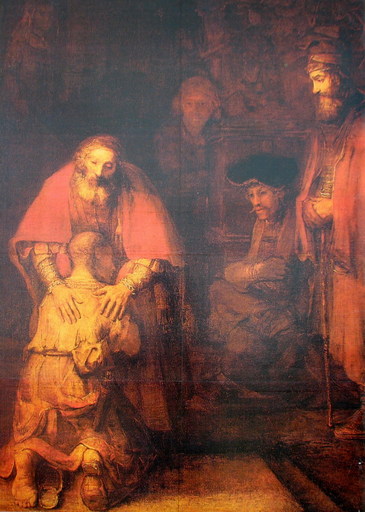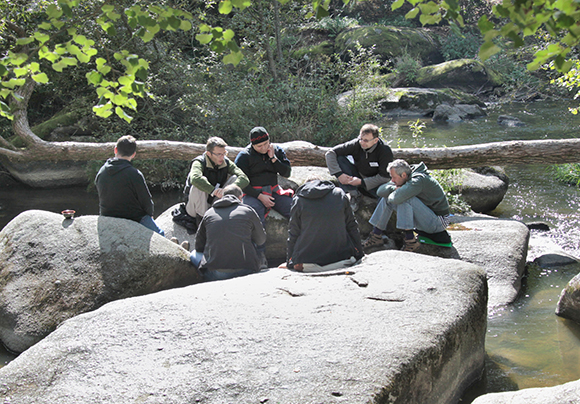
Starý muž, který se neumí smát, je trouba.
Richard Rohr
Kdo jsme?
Tento web reprezentuje hnutí Chlapi, neformální společenství mužů, kteří hledají takové způsoby duchovního prožívání, se kterými se dokážou jako muži ztotožnit a celou bytostí je žít.
Můžeš se tady setkat s muži, kteří usilují o to být lepšími a více autentickými.
Vytváříme jak reálný tak virtuální prostor pro setkávání.
Začalo to někdy před rokem 2000 hledáním mužské energie, spirituality i chlapské party a setkáváním v malých skupinách. Pokračovalo to inspirací dílem Richarda Rohra a jeho Rituálem pro přechod do zralé dospělosti a pokračuje to dodnes stovkami setkání v malých skupinách, víkendovými akcemi pro muže i pro otce a děti, rituály i celostátními setkáními pro stovky účastníků a mezinárodní spoluprací s hnutím mužů po celém světě.
Pro řadu z nás je podstatné přátelství s Bohem, pro všechny jsou oporou kamarádi, které tu nalezli.
Vítáme tě mezi námi a těšíme se na společné putování.

Pavel Hrdina a Martin Šmídek
Překlad meditace CAC z úterý 5. 9. 2023
na téma:
Františkánská cesta
| At-One-Ment není pokání Františkánská alternativní ortodoxie kladla větší důraz na vtělení než na vykoupení. Františkáni nevěřili, že Bůh poslal Ježíše na zem, aby zemřel jako zástupné vykoupení* za naše hříchy. Otec Richard shrnuje: Ve třináctém století byli františkáni a dominikáni takříkajíc církevní debatní společností. V té době jsme směli mít menšinové postoje. Ve velkých debatách na univerzitách v Paříži, Kolíně nad Rýnem a Oxfordu jsme vždy zastávali opačné postoje a ani jeden z názorů nebyl v té době vyhozen z církve. V těchto debatách byli Tomáš Akvinský (1225-1274) a dominikáni věrni Písmu, židovským chrámovým metaforám oběti, ceny a vykoupení. Mnohé pasáže mohou vzbuzovat dojem, že se vyžaduje výkupné. Ale náš františkánský učitel, blahoslavený Jan Duns Scotus (asi 1266-1308), který založil teologickou katedru v Oxfordu, říkal, že Ježíšovo ukřižování nevyřešilo žádné problémy s Bohem ani nezměnilo Boží názor na nás. Boží názor nebylo třeba měnit. Ježíš spíše měnil naše smýšlení o Bohu! Duns Scotus postavil svou argumentaci na novozákonním chápání preexistujícího kosmického Krista v listu Kolosanům, Efezanům a Janově evangeliu. Ježíš je "obraz neviditelného Boha" (Kol 1,15), který vystoupil v okamžiku času, abychom mohli pohlédnout na "toho, kterého jsme probodli" (Jan 19,37), a vidět Boží bezpodmínečnou lásku - a zároveň vidět, co lidé dělají téměř se vším - a Boží bezpodmínečnou láskyplnou odpověď na to. [1] Duns Scotus byl pevně přesvědčen, že Boží svoboda musí být zachována za každou cenu. Pokud Bůh "potřeboval" nebo vyžadoval krvavou oběť, aby mohl milovat své vlastní stvoření, pak nás Bůh svobodně nemiloval. Duns Scotus učil, že Kristus byl od samého počátku plánem A (viz Kol 1,15-20; Ef 1,3-14; Jan 1,1-18). Kristus nebyl plánem B poté, co první lidé zhřešili, což je způsob, jakým většina lidí zřejmě chápe význam Ježíšovy smrti a vzkříšení. Velké tajemství vtělení nebylo motivováno problémem, ale láskou. Františkánský pohled zakládá křesťanství na lásce a svobodě od samého počátku. Vytváří ucelenou a pozitivní spiritualitu, která nás táhne k životu ve vnitřní hloubce, modlitbě, smíření, uzdravení a univerzálnímu sjednocení, namísto jakéhokoli pojetí oběti, které předpokládá rozhněvaného Boha, jehož je třeba vykoupit. [2] Na kříži Ježíš nese následky nenávisti veřejně, ale zcela novým způsobem, který spočívá v odpuštění a propuštění. Nakonec to nazýváme "vzkříšením", a to nejen pro Ježíšovo tělo, ale pro celé dějiny. Je nastolen nový a možný děj. Pokud Bůh a Ježíš nejsou nenávistní, násilní, trestající, mučící nebo mstiví, pak je nám navždy odebrána výmluva na totéž. Celá Ježíšova cesta řekla lidem dvě zásadní věci: že život může mít pozitivní děj a že Bůh je mnohem jiný a mnohem lepší, než jsme si kdy mysleli. [3] Fr. Richard Rohr, OFM přeloženo DeepL | At-One-Ment Not Atonement
Franciscan alternative orthodoxy emphasized incarnation more than redemption. Franciscans did not believe that God sent Jesus to earth to die as a substitutionary atonement* for our sins. Father Richard summarizes: In the thirteenth century, the Franciscans and the Dominicans were the church’s debating society, as it were. We were allowed to have minority positions in those days. We invariably took opposing positions in the great debates in the universities of Paris, Cologne, and Oxford, and neither opinion was kicked out of the church at that time. In these debates, Thomas Aquinas (1225–1274) and the Dominicans were being true to the Scriptures, the Jewish temple metaphors of sacrifice, price, and atonement. Many passages can give the impression that a ransom is required. But our Franciscan teacher, Blessed John Duns Scotus (c. 1266–1308), who founded the theological chair at Oxford, said that Jesus’ crucifixion didn’t solve any problems with God or change God’s mind about us. God’s mind didn’t need changing. Rather, Jesus was changing our mind about God! Duns Scotus built his argument on a New Testament understanding of the pre-existent Cosmic Christ in Colossians, Ephesians, and John’s Gospel. Jesus is “the image of the invisible God” (Colossians 1:15), who came forward in a moment of time so we could look upon “the One we have pierced” (John 19:37) and see God’s unconditional love—and at the same time, see what humans do to almost everything—and God’s unconditional love-response to that. [1] Duns Scotus firmly believed that God’s freedom had to be maintained at all costs. If God “needed” or demanded a blood sacrifice to love God’s own creation, then God was not freely loving us. Duns Scotus taught that Christ was Plan A from the very beginning (see Colossians 1:15–20; Ephesians 1:3–14; John 1:1–18). Christ wasn’t a Plan B after the first humans sinned, which is the way most people seem to understand the significance of Jesus’ death and resurrection. The Great Mystery of Incarnation was not motivated by a problem but by love. The Franciscan view grounds Christianity in love and freedom from the very beginning. It creates a coherent and positive spirituality, which draws us toward lives of inner depth, prayer, reconciliation, healing, and universal at-one-ment, instead of any notion of sacrifice, which implies an angry God who needs to be bought off. [2] On the cross, Jesus bears the consequences of hatred publicly, but in an utterly new way that consists of forgiveness and letting go. We finally call it “resurrection,” not just for Jesus’ body, but for all of history. A new and possible storyline is set forth. If God and Jesus are not hateful, violent, punitive, torturing, or vindictive, then our excuse for the same is forever taken away from us. Jesus’ entire journey told people two major things: that life could have a positive storyline, and that God was far different and far better than we ever thought. [3] Fr. Richard Rohr, OFM |
[1] Adapted from Richard Rohr, Dancing Standing Still: Healing the World from a Place of Prayer (Mahwah, NJ: Paulist Press, 2014), 70–71.
[2] Adapted from Richard Rohr, Franciscan Mysticism: I AM That Which I Am Seeking (Albuquerque, NM: Center for Action and Contemplation, 2012). Available as MP3 download.
[3] Rohr, Dancing Standing Still, 72–73.
*A note on the term “substitutionary atonement”:
Throughout Christian history, there have been multiple theories of substitutionary atonement. One of the earliest, the ransom theory, originated with Origen of Alexandria (c. 185–c. 253). Closely related to this was the Christus Victor theory. The ransom view of atonement was the dominant theory until the publication of Anselm’s Cur Deus Homo? (Why Did God Become Human?) at the end of the eleventh century. Anselm’s satisfaction theory of atonement then became dominant until the Reformed position introduced penal substitution in the sixteenth century. This new view of substitutionary atonement emphasized punishment over satisfaction and paralleled criminal law. Today, the phrase “substitutionary atonement” is often (correctly or incorrectly) used to refer to the penal theory of atonement.
Zde se nacházejí překlady Daily Meditations, jejichž anglické originály se nacházejí na webu CAC. V den jejich vydání je zde nalezneš přeložené strojově pomocí DeepL, zpravidla do druhého dne pak projdou jazykovou úpravou někým z týmu překladatelů :-) Pokud vládneš dobrou angličtinou, přihlas se asi raději přímo u zdroje těchto úvah, tedy na webu CAC. Budeš je pak do své mailové schránky dostávat již k ranní kávě. -mš-
 Myšlenka Richarda Rohra na středu 4. týdne adventního - Pamatuj si všechno Odlož, Jeruzaléme, roucho smutku a trápení a navěky se oblékni důstojností slávy od Boha. Přioděj se pláštěm spravedlnosti od Boha, vlož si na hlavu čelenku slávy Věčného. Neboť Bůh ukáže tvou nádheru všemu pod nebem. Navěky budeš od Boha nazýván „Pokoj spravedlnosti a sláva bohabojnosti“. Vzchop se, Jeruzaléme, postav se na …
Myšlenka Richarda Rohra na středu 4. týdne adventního - Pamatuj si všechno Odlož, Jeruzaléme, roucho smutku a trápení a navěky se oblékni důstojností slávy od Boha. Přioděj se pláštěm spravedlnosti od Boha, vlož si na hlavu čelenku slávy Věčného. Neboť Bůh ukáže tvou nádheru všemu pod nebem. Navěky budeš od Boha nazýván „Pokoj spravedlnosti a sláva bohabojnosti“. Vzchop se, Jeruzaléme, postav se na …




